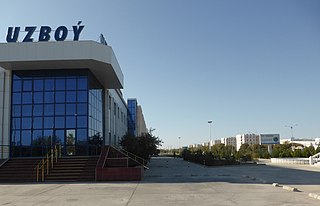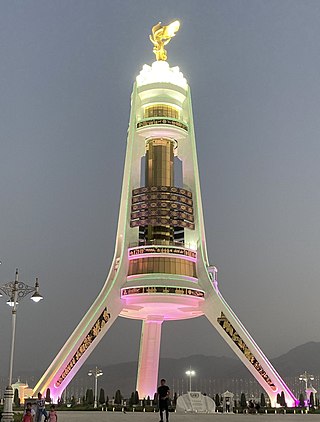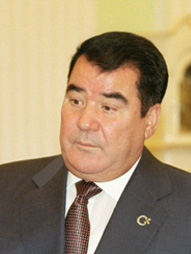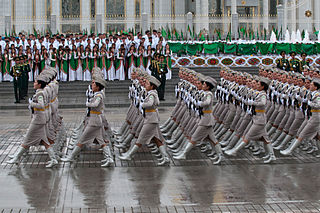
The history of Turkmenistan traditionally began with the arrival of Indo-European Iranian tribes around 2000 BC. Early tribes were nomadic or semi-nomadic due to the arid conditions of the region, preventing widespread adoption of agriculture. The steppe culture in Central Asia was an extension of a larger Eurasian series of horse cultures which spanned the entire spectrum of language families, including the Indo-Europeans and Turko-Mongol groups. Some of the known early Iranian tribes included the Massagatae, the Scythians/Sakas, and early Soghdians, who were most likely precursors of the Khwarezmians. Turkmenistan was a passing point for numerous migrations and invasions by tribes, which gravitated towards the settled regions of the south, including ancient Mesopotamia, Elam, and the Indus Valley civilization.

The politics of Turkmenistan nominally takes place in the framework of a presidential republic, whereby the President of Turkmenistan is nominally both head of state and head of government. However, as of 21 January 2023 a "national leader" was appointed who chairs an independent People's Council (viz.) with authority to amend the constitution, and who exercises supreme political authority. No true opposition parties are allowed; every registered political party supports the third and current President Serdar Berdimuhamedow. The country is frequently described as a totalitarian state.

Ashgabat, also spelled Asgabat, formerly named Poltoratsk between 1919 and 1927, is the capital and the largest city of Turkmenistan. It lies between the Karakum Desert and the Kopetdag mountain range in Central Asia, near the Iran-Turkmenistan border. The city has a population of 1,030,063.

Turkmenistan is a country in Central Asia bordered by Kazakhstan to the northwest, Uzbekistan to the north, east and northeast, Afghanistan to the southeast, Iran to the south and southwest and the Caspian Sea to the west. Ashgabat is the capital and largest city. It is one of the six independent Turkic states. With a population of 6.5 million, Turkmenistan is the 35th most-populous country in Asia and has the lowest population of the Central Asian republics while being one of the most sparsely populated nations on the Asian continent.

The Ruhnama, or Rukhnama, translated into English as Book of the Soul, is a two volume work written by Saparmurat Niyazov, the president of Turkmenistan from 1990 to 2006. It was intended to serve as a tool of state propaganda, emphasising the basis of the Turkmen nation.

Türkmenbaşy, formerly known as Krasnovodsk, Kyzyl-Su, and Shagadam, is a city in Balkan Province in western Turkmenistan, on the Türkmenbaşy Gulf of the Caspian Sea. It sits at an elevation of 27 metres. The population was 86,800, mostly ethnic Turkmens but also Russian, Armenian and Azeri minorities. As the terminus of the Trans-Caspian Railway and site of a major seaport on the Caspian, it is an important transportation center. The city is also the site of Turkmenistan's largest oil refining complex.

Turkmens are a Turkic ethnic group native to Central Asia, living mainly in Turkmenistan, northern and northeastern regions of Iran and north-western Afghanistan. Sizeable groups of Turkmens are found also in Uzbekistan, Kazakhstan, and the North Caucasus. They speak the Turkmen language, which is classified as a part of the Eastern Oghuz branch of the Turkic languages.

Daşoguz, formerly known as Tashauz and Dashkhovuz, is a city in northern Turkmenistan and the capital of Daşoguz Province. The Uzbekistan border is about 10 km away.

Monument of Neutrality is a monument originally located in Ashgabat, Turkmenistan. In 2010, it was moved to the suburbs. The three-legged arch, which became known locally as "The Tripod", was 75 metres (246 ft) tall and was built in 1998 on the orders of the president of Turkmenistan, Saparmurat Niyazov, to commemorate the country's official position of neutrality. It cost $12 million to construct. The monument was topped by a 12-metre (39 ft) tall gold-plated statue of Niyazov which rotated always to face the sun. The arch was located in central Ashgabat where it dominated the skyline, being taller than the nearby Presidential Palace. The statue was illuminated at night. The arch featured a panoramic viewing platform which was a popular attraction for visitors.
The Humanitarian Association of World Turkmens or GATM is the organization meant to bring together Turkmen people in Turkmenistan and other parts of the world.
The Turkmen of Turkmenistan, are predominantly Muslims. According the U.S. Department of State's International Religious Freedom Report for 2022,
According to U.S. government estimates, the country is 93 percent Muslim, 9 percent Eastern Orthodox, and 2 percent other. There are small communities of Jehovah's Witnesses, Shia Muslims, Baha’is, Roman Catholics, the International Society for Krishna Consciousness, and evangelical Christians, including Baptists and Pentecostals. Most ethnic Russians and Armenians identify as Orthodox Christian and generally are members of the Russian Orthodox Church or Armenian Apostolic Church. Some ethnic Russians and Armenians are also members of smaller Protestant groups. There are small pockets of Shia Muslims, consisting largely of ethnic Iranians, Azeris, and Kurds, some located in Ashgabat, with others along the border with Iran and in the western city of Turkmenbashy.

Saparmurat Atayevich Niyazov, also known as Türkmenbaşy, was a Turkmen dictator who ruled Turkmenistan from 1985 until his death in 2006. He was first secretary of the Turkmen Communist Party from 1985 until 1991 and supported the 1991 Soviet coup attempt. He continued to rule Turkmenistan for 15 years after independence from the Soviet Union in 1991.

Public Holidays in Turkmenistan are laid out in the Constitution of Turkmenistan, which acts as a list of nationally recognized public holidays in the country.

The list of Turkmenistan-related articles is below

Corruption in Turkmenistan is a widespread issue, with Turkmenistan being ranked as 19th most corrupt country by the Corruption Perceptions Index.

Independence Square is a square in Ashgabat, Turkmenistan. The identification number of the square is 2000.

The Turkmen Naval Forces is the naval warfare branch of the armed forces of Turkmenistan. Turkmenistan's Navy Day is celebrated annually on October 9. The naval forces were directed by the Border Guard Service until 2009.

The Day of the State Flag of Turkmenistan is an official holiday of Turkmenistan.
Magtymguly Avenue, transliterated from Russian as Makhtumkuli, is an avenue in Ashgabat, Turkmenistan. It is considered to be the longest and most prominent avenue in the capital

The Armed Forces of Turkmenistan currently funds 2 high ranking educational institutions: The Military Academy of Turkmenistan and the Military Institute of the Ministry of Defense of Turkmenistan. Aside from those two schools, there are several military schools around the country, specializing in the training of personnel of a branches of service. In the early 1990s when the armed forces were rapidly being developed, many officers were trained in the Russian Federation's Ministry of Defense, while at least 300 officers were sent to schools in Turkey. On 3 October 1992, the Turkmen State University created the first Turkmen educational department. This article lists institutions of the Turkmen Armed Forces based on its respective agency and service branch.














